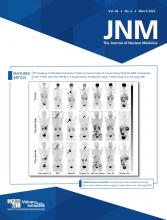In March 2022, 177Lu-PSMA-617 (177Lu-vipivotide tetraxetan) received Food and Drug Administration approval for treatment of metastatic castration-resistant prostate cancer (mCRPC) in men with prostate-specific membrane antigen (PSMA)–avid disease who have received prior chemotherapy and a novel androgen receptor–directed therapy (1). Approval followed the VISION trial, which demonstrated a median 4-mo overall survival benefit for 177Lu-PSMA-617 plus best supportive care versus best supportive care alone (2). 177Lu-PSMA-617 is the first theranostic agent for prostate cancer and a clinically meaningful addition to the therapeutic armamentarium. Here, we describe the process of clinical implementation of 177Lu-PSMA-617 at a major academic center, highlighting successes and challenges.
Between May and October 2022, 146 patients with a median age of 73 y were referred for 177Lu-PSMA-617 therapy at Dana–Farber Cancer Institute. Cognizant of potential access issues, once 177Lu-PSMA-617 was Food and Drug Administration–approved, we developed a standard operating process as the only gateway to receiving therapy. This involved practitioners ordering 68Ga-PSMA-11 PET/CT and noting on the requisition that the patient was being considered for 177Lu-PSMA-617. Once the PSMA PET/CT was performed, cases were reviewed at a weekly multidisciplinary tumor board (TB) meeting with representation from the Genitourinary Medical Oncology Department and the Nuclear Medicine Department. The median duration between PSMA PET/CT and TB review was 11 d (interquartile range, 6–20 d). Of the cohort, 127 (88%) were approved for therapy, 10 (7%) were deferred, and 8 (6%) were declined for reasons such as no prior chemotherapy, lack of PSMA-avid disease, poor performance status, or poor organ function. All approved patients had received a prior taxane and a novel androgen receptor–directed agent. As of October 31, 2022, 52 patients (41% of those approved) had received at least 1 cycle of 177Lu-PSMA-617. The median duration between TB review and cycle 1 was 59 d (range, 32–129 d), with the median delay increasing from 41 d in May 2022 to 96 d in October 2022. Due to the delay, 45 patients (35%) continued existing therapy or started a new line of therapy between baseline PSMA PET/CT and cycle 1 of 177Lu-PSMA-617. Six patients (5%) died before receiving 177Lu-PSMA-617.
Our experiences highlight several issues. First, establishing a referral process for 177Lu-PSMA-617, including a multidisciplinary TB, has been key in managing volume and coordinating care. TBs facilitate open dialog for selecting patients for therapy on the basis of PSMA PET/CT imaging and clinical judgment at the individual-patient level about the broader therapeutic options available at the specific point in the disease.
Second, supply issues, currently causing more than a 3-mo delay in 177Lu-PSMA-617 administration, have had a notable impact, with 5% of patients dying while waiting for treatment. These delays have led to delivery of bridging therapy (chemotherapy, novel androgen receptor–directed agents, radiotherapy), which dilutes the impact of 177Lu-PSMA-617 as a theranostic agent and increases toxicity risks. Since decisions on proceeding with 177Lu-PSMA-617 therapy are being based on PSMA PET/CT performed 3–4 mo beforehand, and with patients receiving bridging therapies, it is likely that disease differs in terms of extent of PSMA-negative disease, visceral metastases, or other poor-prognosis factors between the time of PSMA PET/CT and 177Lu-PSMA-617 administration. This also impacts how disease is followed radiographically during therapy, especially if PSMA PET/CT is used to monitor therapy response.
Finally, these issues serve as a reminder about selecting patients for 177Lu-PSMA-617. The fact that a patient has PSMA-avid disease (as >90% of patients with mCRPC will, per the VISION trial criteria) (2) should not automatically mean that 177Lu-PSMA-617 treatment is indicated. At our center, we treat patients per the Food and Drug Administration label and VISION population, with no exceptions for patients who have not had both prior chemotherapy and novel androgen receptor–axis inhibitor treatment. Additionally, for those with limited PSMA-avid disease, we consider metastasis-directed therapy given encouraging results from prospective trials in hormone-sensitive prostate cancer (3–5) and retrospective data suggesting utility in mCRPC (6). Furthermore, second-line chemotherapy (cabazitaxel) is a valid option in patients who have received prior docetaxel, with the THERA-P trial showing similar overall survival between 177Lu-PSMA-617 and cabazitaxel in the post-docetaxel setting (7,8). There are prognostic nomograms available that may help select patients (9). However, unfortunately, those least likely to benefit from 177Lu-PSMA-617 are often those in most need of a new line of therapy (i.e., heavily pretreated, visceral disease, poorer organ function).
While radiopharmaceutical therapy is not new to prostate cancer (223Ra is used in bone-predominant mCRPC (10)), and though the wider acceptance and use of theranostics is promising, the clinical roll-out of 177Lu-PSMA-617 has posed unique challenges due to the need for selection by PSMA PET/CT, supply shortages of drug, and the time between imaging and treatment administration. We believe that close collaboration between medical oncology and nuclear medicine, multidisciplinary TBs, and careful patient selection can address these challenges through streamlined processes, which will be necessary as the demands for treatment are likely to increase pending data from trials evaluating 177Lu-PSMA-617 in earlier settings of prostate cancer disease (PSMAddition, NCT04720157; PSMAfore, NCT04689828).
DISCLOSURE
No potential conflict of interest relevant to this article was reported.
Footnotes
Published online Jan. 26, 2023.
- © 2023 by the Society of Nuclear Medicine and Molecular Imaging.
REFERENCES
- Received for publication November 14, 2022.
- Revision received January 4, 2023.







